A Computer-Vision-Based Approach for Nitrogen Content Estimation in Plant Leaves
Abstract
:1. Introduction
2. Review of Existing Methods
3. Methodology
3.1. Image Processing
3.1.1. Image Acquisition
3.1.2. Region of Interest Detection
3.1.3. Background Removal
3.1.4. Nitrogen Estimation
3.2. Model Development
3.2.1. Euclidean Distance
3.2.2. Color Approximation Distance
3.2.3. CIEXYZ
3.2.4. CIE76
3.2.5. CIE94
3.2.6. CIEDE2000
3.2.7. CMC l:c
4. Evaluation of Dataset
4.1. Sample Collection and Processing
4.2. Performance Evaluation Parameters
5. Results and Discussion
6. Conclusions and Future Research Directions
Author Contributions
Funding
Institutional Review Board Statement
Informed Consent Statement
Conflicts of Interest
References
- Buchaillot, M.; Gracia-Romero, A.; Vergara-Diaz, O.; Zaman-Allah, M.A.; Tarekegne, A.; Cairns, J.E.; Prasanna, B.M.; Araus, J.L.; Kefauver, S.C. Evaluating Maize Genotype Performance under Low Nitrogen Conditions Using RGB UAV Phenotyping Techniques. Sensors 2019, 19, 1815. [Google Scholar] [CrossRef] [Green Version]
- Hamid, F.; Ahmad, T.; Waheed, A.; Ahmad, N.; Aslam, S. Effect of different levels of nitrogen on the chemical composition of tea (C. Sinensis L.) grown at higher altitude. J. Mater. Environ. Sci. 2014, 5, 72–80. [Google Scholar]
- Leghari, S.J.; Wahocho, N.A.; Laghari, G.M.; HafeezLaghari, A.; MustafaBhabhan, G.; HussainTalpur, K.; Bhutto, T.A.; Wahocho, S.A.; Lashari, A.A. Role of nitrogen for plant growth and development: A review. Adv. Environ. Biol. 2016, 10, 209–219. [Google Scholar]
- Tewari, V.; Arudra, A.K.; Kumar, S.P.; Pandey, V.; Chandel, N.S. Estimation of plant nitrogen content using digital image processing. Agric. Eng. Int. CIGR J. 2013, 15, 78–86. [Google Scholar]
- Shi, P.; Wang, Y.; Xu, J.; Zhao, Y.; Yang, B.; Yuan, Z.; Sun, Q. Rice nitrogen nutrition estimation with RGB images and machine learning methods. Comput. Electron. Agric. 2021, 180, 105860. [Google Scholar] [CrossRef]
- Tavakoli, H.; Gebbers, R. Assessing Nitrogen and water status of winter wheat using a digital camera. Comput. Electron. Agric. 2019, 157, 558–567. [Google Scholar] [CrossRef]
- Nebiker, S.; Annen, A.; Scherrer, M.; Oesch, D. A light-weight multispectral sensor for micro UAV—Opportunities for very high resolution airborne remote sensing. Int. Arch. Photogramm. Remote Sens. Spat. Inf. Sci. 2008, 37, 1193–1199. [Google Scholar]
- Fageria, N.; Baligar, V. Enhancing nitrogen use efficiency in crop plants. Adv. Agron. 2005, 88, 97–185. [Google Scholar]
- Zulkifli, Z.; Khairunniza-Bejo, S. Paddy growth monitoring using terrestrial laser scanner. Aust. J. Basic Appl. Sci. 2015, 9, 90–96. [Google Scholar]
- López-Calderón, M.J.; Estrada-Ávalos, J.; Rodríguez-Moreno, V.M.; Mauricio-Ruvalcaba, J.E.; Martínez-Sifuentes, A.R.; Delgado-Ramírez, G.; Miguel-Valle, E. Estimation of Total Nitrogen Content in Forage Maize (Zea mays L.) Using Spectral Indices: Analysis by Random Forest. Agriculture 2020, 10, 451. [Google Scholar] [CrossRef]
- Coste, S.; Baraloto, C.; Leroy, C.; Marcon, É.; Renaud, A.; Richardson, A.D.; Roggy, J.C.; Schimann, H.; Uddling, J.; Hérault, B. Assessing foliar chlorophyll contents with the SPAD-502 chlorophyll meter: A calibration test with thirteen tree species of tropical rainforest in French Guiana. Ann. For. Sci. 2010, 67, 607. [Google Scholar] [CrossRef] [Green Version]
- Wu, B.; Huang, W.; Ye, H.; Luo, P.; Ren, Y.; Kong, W. Using Multi-Angular Hyperspectral Data to Estimate the Vertical Distribution of Leaf Chlorophyll Content in Wheat. Remote Sens. 2021, 13, 1501. [Google Scholar] [CrossRef]
- Colorado, J.D.; Cera-Bornacelli, N.; Caldas, J.S.; Petro, E.; Rebolledo, M.C.; Cuellar, D.; Calderon, F.; Mondragon, I.F.; Jaramillo-Botero, A. Estimation of Nitrogen in Rice Crops from UAV-Captured Images. Remote Sens. 2020, 12, 3396. [Google Scholar] [CrossRef]
- Campoe, O.C.; Iannelli, C.; Stape, J.L.; Cook, R.L.; Mendes, J.C.T.; Vivian, R. Atlantic forest tree species responses to silvicultural practices in a degraded pasture restoration plantation: From leaf physiology to survival and initial growth. For. Ecol. Manag. 2014, 313, 233–242. [Google Scholar] [CrossRef]
- Aranguren, M.; Castellón, A.; Aizpurua, A. Crop Sensor Based Non-destructive Estimation of Nitrogen Nutritional Status, Yield, and Grain Protein Content in Wheat. Agriculture 2020, 10, 148. [Google Scholar] [CrossRef]
- El-Shikha, D.M.; Barnes, E.M.; Clarke, T.R.; Hunsaker, D.J.; Haberland, J.A.; Pinter, P., Jr.; Waller, P.M.; Thompson, T.L. Remote sensing of cotton nitrogen status using the Canopy Chlorophyll Content Index (CCCI). Trans. ASABE 2008, 51, 73–82. [Google Scholar] [CrossRef]
- Yang, J.; Song, S.; Du, L.; Shi, S.; Gong, W.; Sun, J.; Chen, B. Analyzing the Effect of Fluorescence Characteristics on Leaf Nitrogen Concentration Estimation. Remote Sens. 2018, 10, 1402. [Google Scholar] [CrossRef] [Green Version]
- Uchida, R. Essential nutrients for plant growth: Nutrient functions and deficiency symptoms. Plant Nutr. Manag. Hawaii’s Soils 2000, 4, 31–55. [Google Scholar]
- Wankhede, A.; Waghmare, S.; Joshi, B. Embedded System Development for Estimation of Nitrogen Content of Plants for Healthy Crops. IJETT 2015, 2, 237–240. [Google Scholar]
- Fu, Y.; Yang, G.; Pu, R.; Li, Z.; Li, H.; Xu, X.; Song, X.; Yang, X.; Zhao, C. An overview of crop nitrogen status assessment using hyperspectral remote sensing: Current status and perspectives. Eur. J. Agron. 2021, 124, 126241. [Google Scholar] [CrossRef]
- Sunagar, V.B.; Kattimani, P.A.; Padasali, V.A.; Hiremath, N.V. Estimation of Nitrogen Content in Leaves Uisng Image Processing. In Proceedings of the International Conference on Advances in Engineering & Technology, Goa, India, 20 April 2014. [Google Scholar]
- Zheng, H.; Li, W.; Jiang, J.; Liu, Y.; Cheng, T.; Tian, Y.; Zhu, Y.; Cao, W.; Zhang, Y.; Yao, X. A Comparative Assessment of Different Modeling Algorithms for Estimating Leaf Nitrogen Content in Winter Wheat Using Multispectral Images from an Unmanned Aerial Vehicle. Remote Sens. 2018, 10, 2026. [Google Scholar] [CrossRef] [Green Version]
- Kawashima, S.; Nakatani, M. An Algorithm for Estimating Chlorophyll Content in Leaves Using a Video Camera. Ann. Bot. 1998, 81, 49–54. [Google Scholar] [CrossRef] [Green Version]
- Yuzhu, H.; Xiaomei, W.; Shuyao, S. Nitrogen determination in pepper (Capsicum frutescens L.) plants by color image analysis (RGB). Afr. J. Biotechnol. 2011, 10, 17737–17741. [Google Scholar]
- Li, Y.; Chen, D.; Walker, C.; Angus, J. Estimating the nitrogen status of crops using a digital camera. Field Crop. Res. 2010, 118, 221–227. [Google Scholar] [CrossRef]
- Vibhute, A.; Bodhe, S. Color image processing approach for nitrogen estimation of vineyard. Int. J. Agric. Sci. Res. 2013, 3, 189–196. [Google Scholar]
- Dey, A.K.; Sharma, M.; Meshram, M. An analysis of leaf chlorophyll measurement method using chlorophyll meter and image processing technique. Procedia Comput. Sci. 2016, 85, 286–292. [Google Scholar] [CrossRef] [Green Version]
- Wang, Y.; Wang, D.; Shi, P.; Omasa, K. Estimating rice chlorophyll content and leaf nitrogen concentration with a digital still color camera under natural light. Plant Methods 2014, 10, 36. [Google Scholar] [CrossRef] [Green Version]
- Rigon, J.; Capuani, S.; Fernandes, D.; Guimarães, T. A novel method for the estimation of soybean chlorophyll content using a smartphone and image analysis. Photosynthetica 2016, 54, 559–566. [Google Scholar] [CrossRef] [Green Version]
- Ali, M.M.; Al-Ani, A.; Eamus, D.; Tan, D.K. A new image processing based technique to determine chlorophyll in plants. Am.-Eurasian J. Agric. Environ. Sci. 2012, 12, 1323–1328. [Google Scholar]
- Riccardi, M.; Mele, G.; Pulvento, C.; Lavini, A.; d’Andria, R.; Jacobsen, S.E. Non-destructive evaluation of chlorophyll content in quinoa and amaranth leaves by simple and multiple regression analysis of RGB image components. Photosynth. Res. 2014, 120, 263–272. [Google Scholar] [CrossRef]
- Muñoz-Huerta, R.; Guevara-Gonzalez, R.; Contreras-Medina, L.; Torres-Pacheco, I.; Prado-Olivarez, J.; Ocampo-Velazquez, R. A review of methods for sensing the nitrogen status in plants: Advantages, disadvantages and recent advances. Sensors 2013, 13, 10823–10843. [Google Scholar] [CrossRef] [PubMed]
- Kjeldahl, J. Neue methode zur bestimmung des stickstoffs in organischen körpern. Fresenius’ J. Anal. Chem. 1883, 22, 366–382. [Google Scholar] [CrossRef] [Green Version]
- Michałowski, T.; Asuero, A.G.; Wybraniec, S. The titration in the Kjeldahl method of nitrogen determination: Base or acid as titrant? J. Chem. Educ. 2012, 90, 191–197. [Google Scholar] [CrossRef]
- Jaroenseng, S.; Wongmaneeroj, A.; Amkhab, S. Results of studies the possible correlations between SPAD value and total nitrogen contents in the leaves of sugarcane (Saccharum officinarum L.). J. Int. Soc. S. Asian Agric. Sci. 2010, 16, 136. [Google Scholar]
- Demotes-Mainard, S.; Boumaza, R.; Meyer, S.; Cerovic, Z.G. Indicators of nitrogen status for ornamental woody plants based on optical measurements of leaf epidermal polyphenol and chlorophyll contents. Sci. Hortic. 2008, 115, 377–385. [Google Scholar] [CrossRef]
- Sen, A.; Srivastava, V.K.; Singh, M.K.; Singh, R.K.; Kumar, S. Leaf colour chart vis-a-vis nitrogen management in different rice genotypes. Am. J. Plant Sci. 2011, 2, 223. [Google Scholar] [CrossRef] [Green Version]
- Gao, B.C. NDWI—A normalized difference water index for remote sensing of vegetation liquid water from space. Remote Sens. Environ. 1996, 58, 257–266. [Google Scholar] [CrossRef]
- Rorie, R.L.; Purcell, L.C.; Mozaffari, M.; Karcher, D.E.; King, C.A.; Marsh, M.C.; Longer, D.E. Association of “greenness” in corn with yield and leaf nitrogen concentration. Agron. J. 2011, 103, 529–535. [Google Scholar] [CrossRef] [Green Version]
- Sims, D.A.; Gamon, J.A. Relationships between leaf pigment content and spectral reflectance across a wide range of species, leaf structures and developmental stages. Remote Sens. Environ. 2002, 81, 337–354. [Google Scholar] [CrossRef]
- Zhao, B.; Zhang, Y.; Duan, A.; Liu, Z.; Xiao, J.; Liu, Z.; Qin, A.; Ning, D.; Li, S.; Ata-Ul-Karim, S.T. Estimating the Growth Indices and Nitrogen Status Based on Color Digital Image Analysis During Early Growth Period of Winter Wheat. Front. Plant Sci. 2021, 12, 502. [Google Scholar] [CrossRef] [PubMed]
- Adhikari, R.; Li, C.; Kalbaugh, K.; Nemali, K. A low-cost smartphone controlled sensor based on image analysis for estimating whole-plant tissue nitrogen (N) content in floriculture crops. Comput. Electron. Agric. 2020, 169, 105173. [Google Scholar] [CrossRef]
- Gu, D.D.; Wang, W.Z.; Hu, J.D.; Zhang, X.M.; Wang, J.B.; Wang, B.S. Nondestructive Determination of Total Chlorophyll Content in Maize Using Three-Wavelength Diffuse Reflectance. J. Appl. Spectrosc. 2016, 83, 541–547. [Google Scholar] [CrossRef]
- Wahono, W.; Indradewa, D.; Sunarminto, B.H.; Haryono, E.; Prajitno, D. CIE L* a* b* Color Space Based Vegetation Indices Derived from Unmanned Aerial Vehicle Captured Images for Chlorophyll and Nitrogen Content Estimation of Tea (Camellia sinensis L. Kuntze) Leaves. Ilmu Pertan. 2019, 4, 46–51. [Google Scholar] [CrossRef]
- Hunt, E.R., Jr.; Doraiswamy, P.C.; McMurtrey, J.E.; Daughtry, C.S.; Perry, E.M.; Akhmedov, B. A visible band index for remote sensing leaf chlorophyll content at the canopy scale. Int. J. Appl. Earth Obs. Geoinf. 2013, 21, 103–112. [Google Scholar] [CrossRef] [Green Version]
- Janwale, A.P.; Lomte, S.S. Automatic estimation of nitrogen content in cotton (Gossypium hirsutum L.) plant by using image processing techniques: A review. Int. J. Comput. Appl. 2015, 975, 8887. [Google Scholar]
- Sayeed, M.A.; Shashikala, G.; Pandey, S.; Jain, R.; Kumar, S.N. Estimation of Nitrogen in Rice Plant Using Image Processing and Artificial Neural Networks. Imp. J. Interdiscip. Res. 2016, 2, 1074–1079. [Google Scholar]
- Jia, B.; He, H.; Ma, F.; Diao, M.; Jiang, G.; Zheng, Z.; Cui, J.; Fan, H. Use of a digital camera to monitor the growth and nitrogen status of cotton. Sci. World J. 2014, 2014. [Google Scholar] [CrossRef] [PubMed]
- Fernandez-Jaramillo, A.A.; de Jesus Romero-Troncoso, R.; Duarte-Galvan, C.; Torres-Pacheco, I.; Guevara-Gonzalez, R.G.; Contreras-Medina, L.M.; Herrera-Ruiz, G.; Millan-Almaraz, J.R. FPGA-based chlorophyll fluorescence measurement system with arbitrary light stimulation waveform using direct digital synthesis. Measurement 2015, 75, 12–22. [Google Scholar] [CrossRef]
- Pérez-Patricio, M.; Camas-Anzueto, J.; Sanchez-Alegría, A.; Aguilar-González, A.; Gutiérrez-Miceli, F.; Escobar-Gómez, E.; Voisin, Y.; Rios-Rojas, C.; Grajales-Coutiño, R. Optical method for estimating the Chlorophyll Contents in Plant Leaves. Sensors 2018, 18, 650. [Google Scholar] [CrossRef] [Green Version]
- do Amaral, E.S.; Silva, D.V.; Dos Anjos, L.; Schilling, A.C.; Dalmolin, Â.C.; Mielke, M.S. Relationships between reflectance and absorbance chlorophyll indices with RGB (Red, Green, Blue) image components in seedlings of tropical tree species at nursery stage. New For. 2019, 50, 377–388. [Google Scholar] [CrossRef]
- Putra, B.T.W.; Soni, P. Enhanced broadband greenness in assessing Chlorophyll a and b, Carotenoid, and Nitrogen in Robusta coffee plantations using a digital camera. Precis. Agric. 2018, 19, 238–256. [Google Scholar] [CrossRef]
- Gong, A.; Yu, J.; He, Y.; Qiu, Z. Citrus yield estimation based on images processed by an Android mobile phone. Biosyst. Eng. 2013, 115, 162–170. [Google Scholar] [CrossRef]
- Murakami, P.F.; Turner, M.R.; van den Berg, A.K.; Schaberg, P.G. An Instructional Guide for Leaf Color Analysis Using Digital Imaging Software; Gen. Tech. Rep. NE-327; US Department of Agriculture, Forest Service, Northeastern Research Station: Newtown Square, PA, USA, 2005; Volume 327, 33p. [Google Scholar]
- Ye, X.; Abe, S.; Zhang, S. Estimation and mapping of nitrogen content in apple trees at leaf and canopy levels using hyperspectral imaging. Precis. Agric. 2019, 21, 198–225. [Google Scholar] [CrossRef]
- Nurhadiyatna, A.; Jatmiko, W.; Hardjono, B.; Wibisono, A.; Sina, I.; Mursanto, P. Background subtraction using gaussian mixture model enhanced by hole filling algorithm (GMMHF). In Proceedings of the 2013 IEEE International Conference on Systems, Man, and Cybernetics, Manchester, UK, 13–16 October 2013; pp. 4006–4011. [Google Scholar]
- Farid, M.S.; Lucenteforte, M.; Grangetto, M. DOST: A distributed object segmentation tool. Multimed. Tools Appl. 2017, 77, 20839–20862. [Google Scholar] [CrossRef] [Green Version]
- Kuehni, R.G. Industrial color difference: Progress and problems. Color Res. Appl. 1990, 15, 261–265. [Google Scholar] [CrossRef]
- International Commission on Illumination (CIE). Industrial Colour-Difference Evaluation; CIE Technical Reports; CIE Central Bureau: Vienna, Austria, 1995. [Google Scholar]
- Smith, T.; Guild, J. The C.I.E. colorimetric standards and their use. Trans. Opt. Soc. 1931, 33, 73–134. [Google Scholar] [CrossRef]
- Sharma, G.; Bala, R. Digital Color Imaging Handbook; CRC Press: Boca Raton, FL, USA, 2017. [Google Scholar]
- McDonald, R.; Smith, K. CIE94-a new colour-difference formula. J. Soc. Dye Colour. 1995, 111, 376–379. [Google Scholar] [CrossRef]
- Melgosa, M. CIE94, History, Use, and Performance. Encycl. Color Sci. Technol. 2014. [Google Scholar] [CrossRef]
- Luo, M.R.; Cui, G.; Rigg, B. The development of the CIE 2000 colour-difference formula: CIEDE2000. Color Res. Appl. 2001, 26, 340–350. [Google Scholar] [CrossRef]
- Cheung, V. Uniform Color Spaces. In Handbook of Visual Display Technology; Springer: Berlin/Heidelberg, Germany, 2012; pp. 161–169. [Google Scholar] [CrossRef]
- Baldevbhai, P.J.; Anand, R. Color image segmentation for medical images using L* a* b* color space. IOSR J. Electron. Commun. Eng. 2012, 1, 24–45. [Google Scholar] [CrossRef]
- Sheikh, H.; Sabir, M.; Bovik, A. A Statistical Evaluation of Recent Full Reference Image Quality Assessment Algorithms. IEEE Trans. Image Process. 2006, 15, 3440–3451. [Google Scholar] [CrossRef]
- Mercado-Luna, A.; Rico-García, E.; Lara-Herrera, A.; Soto-Zarazúa, G.; Ocampo-Velázquez, R.; Guevara-González, R.; Herrera-Ruiz, G.; Torres-Pacheco, I. Nitrogen determination on tomato (Lycopersicon esculentum Mill.) seedlings by color image analysis (RGB). Afr. J. Biotechnol. 2010, 9, 5326–5332. [Google Scholar]
- Liu, Y.J.; Tong, Y.P.; Zhu, Y.G.; Ding, H.; Smith, F.A. Leaf Chlorophyll Readings as an Indicator for Spinach Yield and Nutritional Quality with Different Nitrogen Fertilizer Applications. J. Plant Nutr. 2006, 29, 1207–1217. [Google Scholar] [CrossRef]
- Muchecheti, F.; Madakadze, C.; Soundy, P. Leaf chlorophyll readings as an indicator of nitrogen status and yield of spinach (Spinacia oleracea L.) grown in soils amended with Luecaena leucocephala prunings. J. Plant Nutr. 2016, 39, 539–561. [Google Scholar] [CrossRef]
- Pagola, M.; Ortiz, R.; Irigoyen, I.; Bustince, H.; Barrenechea, E.; Aparicio-Tejo, P.; Lamsfus, C.; Lasa, B. New method to assess barley nitrogen nutrition status based on image colour analysis: Comparison with SPAD-502. Comput. Electron. Agric. 2009, 65, 213–218. [Google Scholar] [CrossRef]
- Agarwal, A.; Dutta Gupta, S. Assessment of spinach seedling health status and chlorophyll content by multivariate data analysis and multiple linear regression of leaf image features. Comput. Electron. Agric. 2018, 152, 281–289. [Google Scholar] [CrossRef]
- Mendoza-Tafolla, R.O.; Juarez-Lopez, P.; Ontiveros-Capurata, R.E.; Sandoval-Villa, M.; Iran, A.T.; Alejo-Santiago, G. Estimating Nitrogen and Chlorophyll Status of Romaine Lettuce Using SPAD and at LEAF Readings. Not. Bot. Horti Agrobot. Cluj Napoca 2019, 47. [Google Scholar] [CrossRef] [Green Version]
- Noh, H.; Zhang, Q. Shadow effect on multi-spectral image for detection of nitrogen deficiency in corn. Comput. Electron. Agric. 2012, 83, 52–57. [Google Scholar] [CrossRef]
- Borhan, M.; Panigrahi, S.; Satter, M.; Gu, H. Evaluation of computer imaging technique for predicting the SPAD readings in potato leaves. Inf. Process. Agric. 2017, 4, 275–282. [Google Scholar] [CrossRef]
- Graeff, S.; Pfenning, J.; Claupein, W.; Liebig, H.P. Evaluation of Image Analysis to Determine the N-Fertilizer Demand of Broccoli Plants (Brassica oleracea convar. botrytis var. italica). Adv. Opt. Technol. 2008, 2008, 1–8. [Google Scholar] [CrossRef] [Green Version]
- Dong, T.; Shang, J.; Chen, J.M.; Liu, J.; Qian, B.; Ma, B.; Morrison, M.J.; Zhang, C.; Liu, Y.; Shi, Y.; et al. Assessment of Portable Chlorophyll Meters for Measuring Crop Leaf Chlorophyll Concentration. Remote Sens. 2019, 11, 2706. [Google Scholar] [CrossRef] [Green Version]
- Xia, T.; Miao, Y.; Mi, G.; Khosla, R.; Wu, D.; Shao, H.; Xu, X. In-season estimation of spring maize nitrogen status with GreenSeeker active canopy sensor. In Proceedings of the 2015 Fourth International Conference on Agro-Geoinformatics (Agro-Geoinformatics), Istanbul, Turkey, 20–24 July 2015; pp. 390–395. [Google Scholar] [CrossRef]
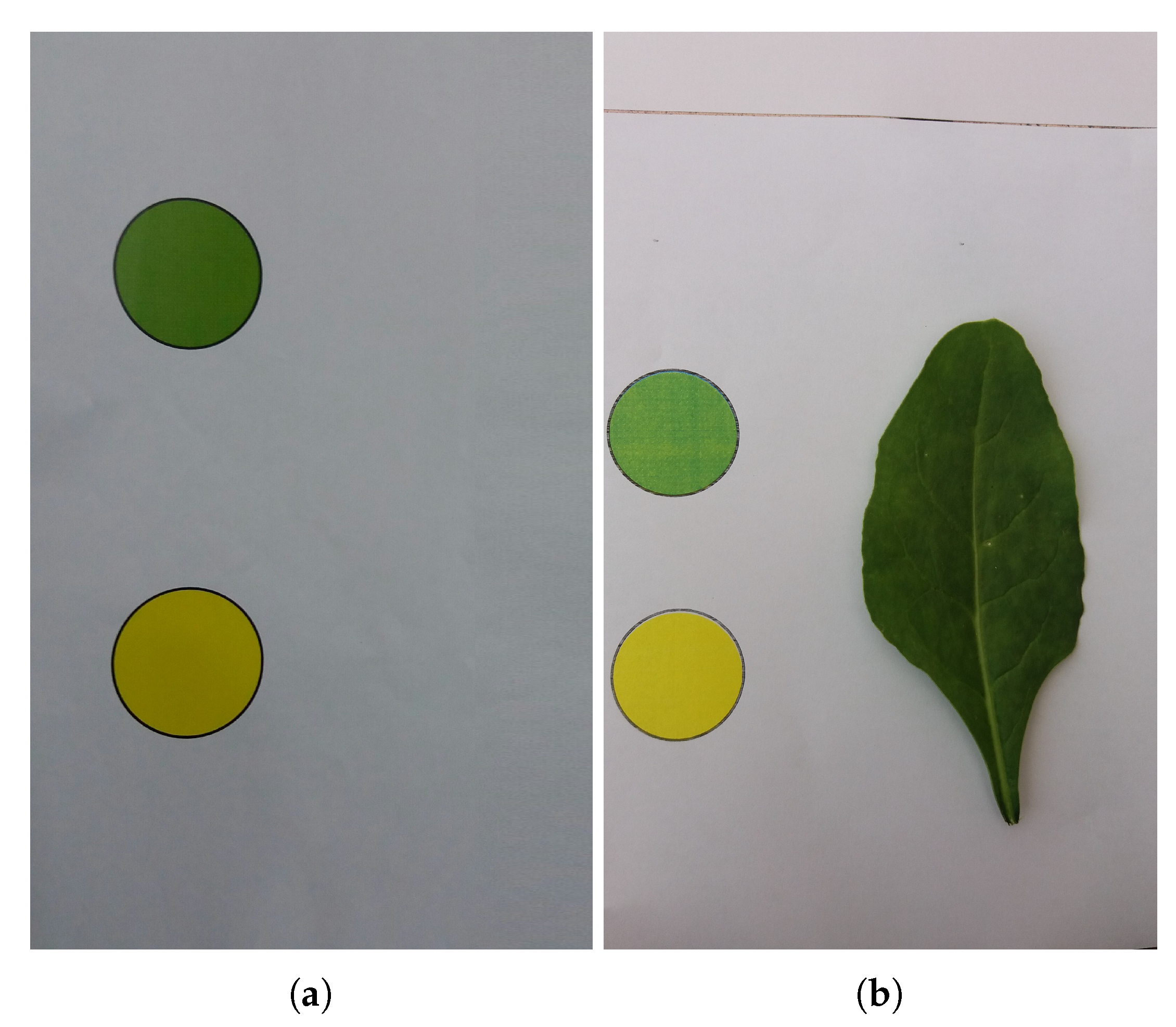
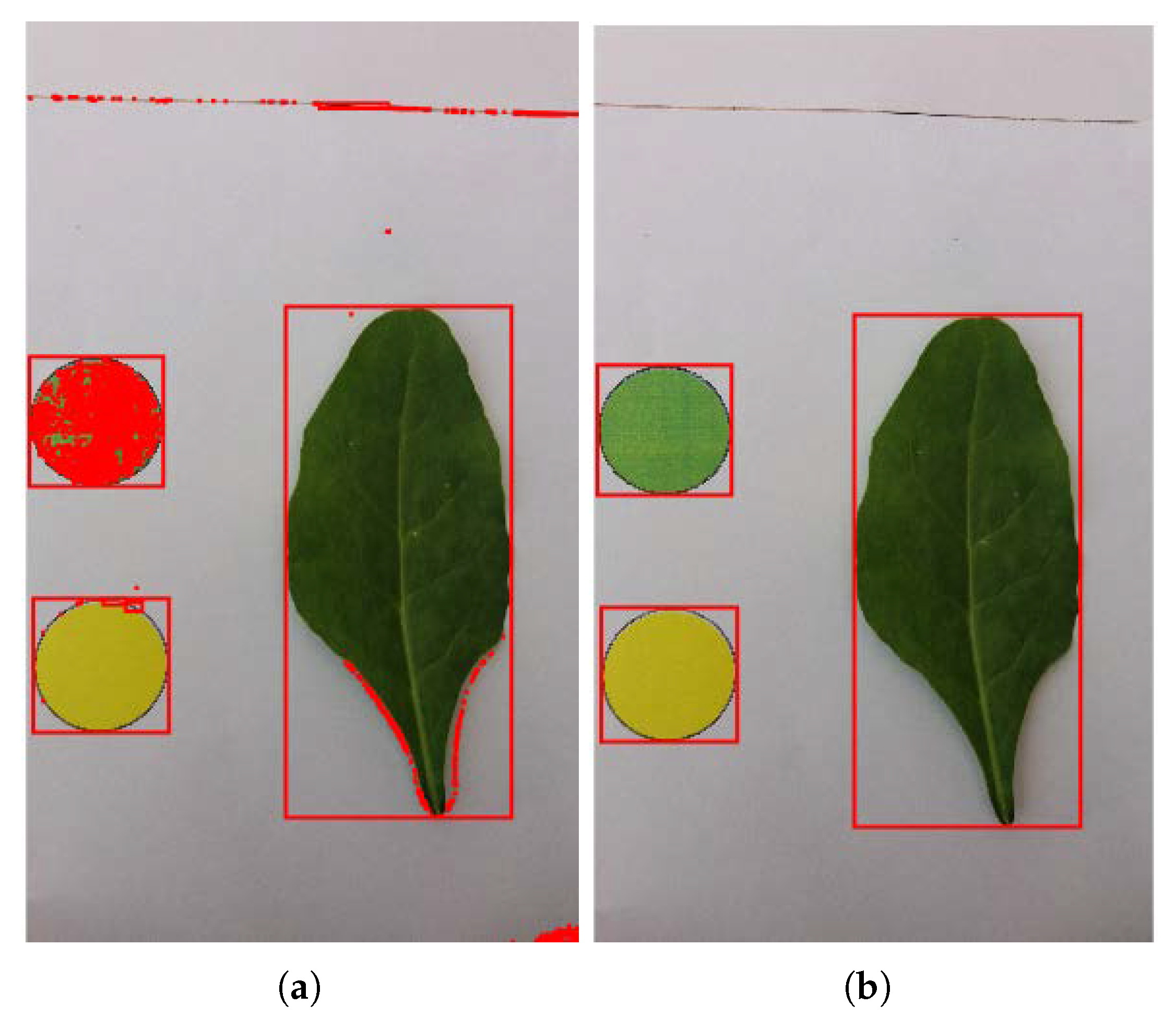
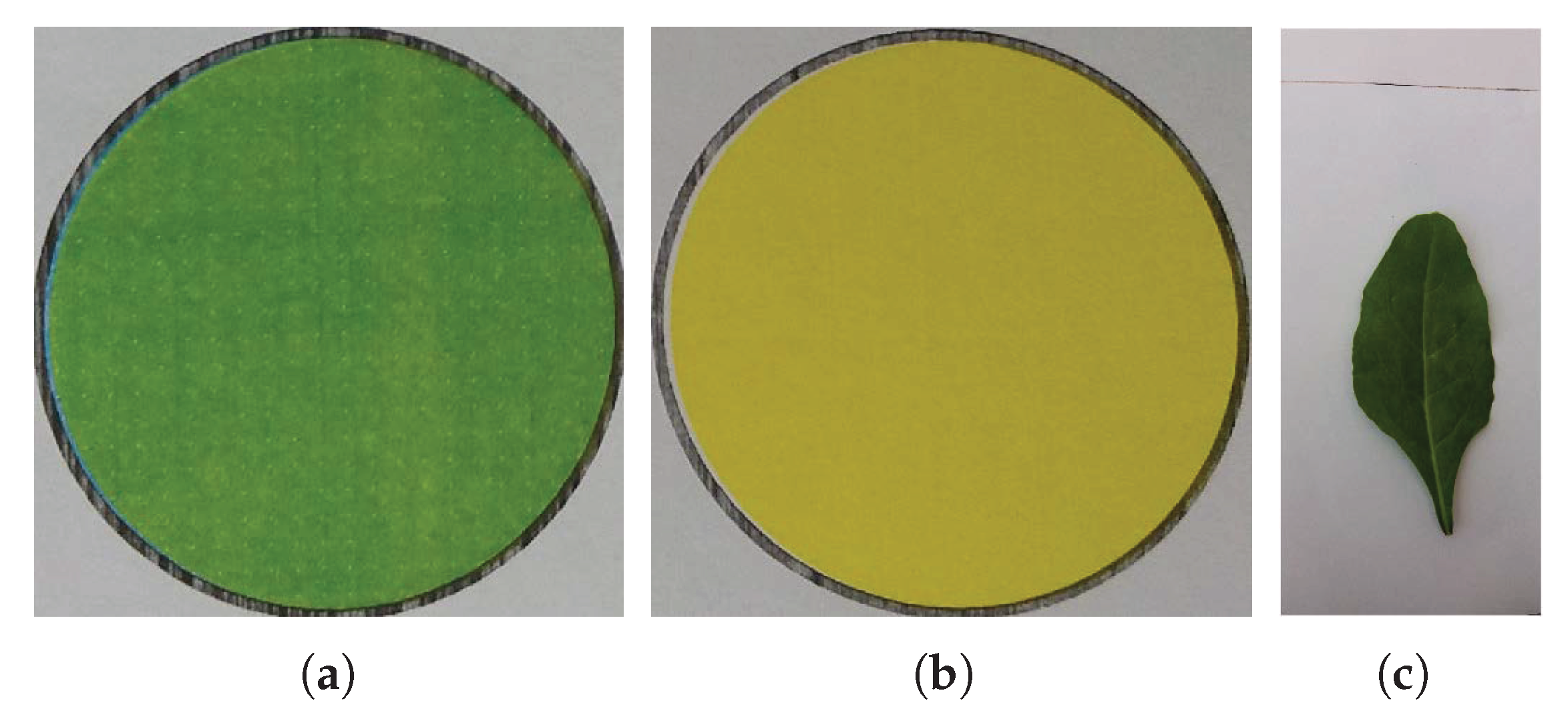
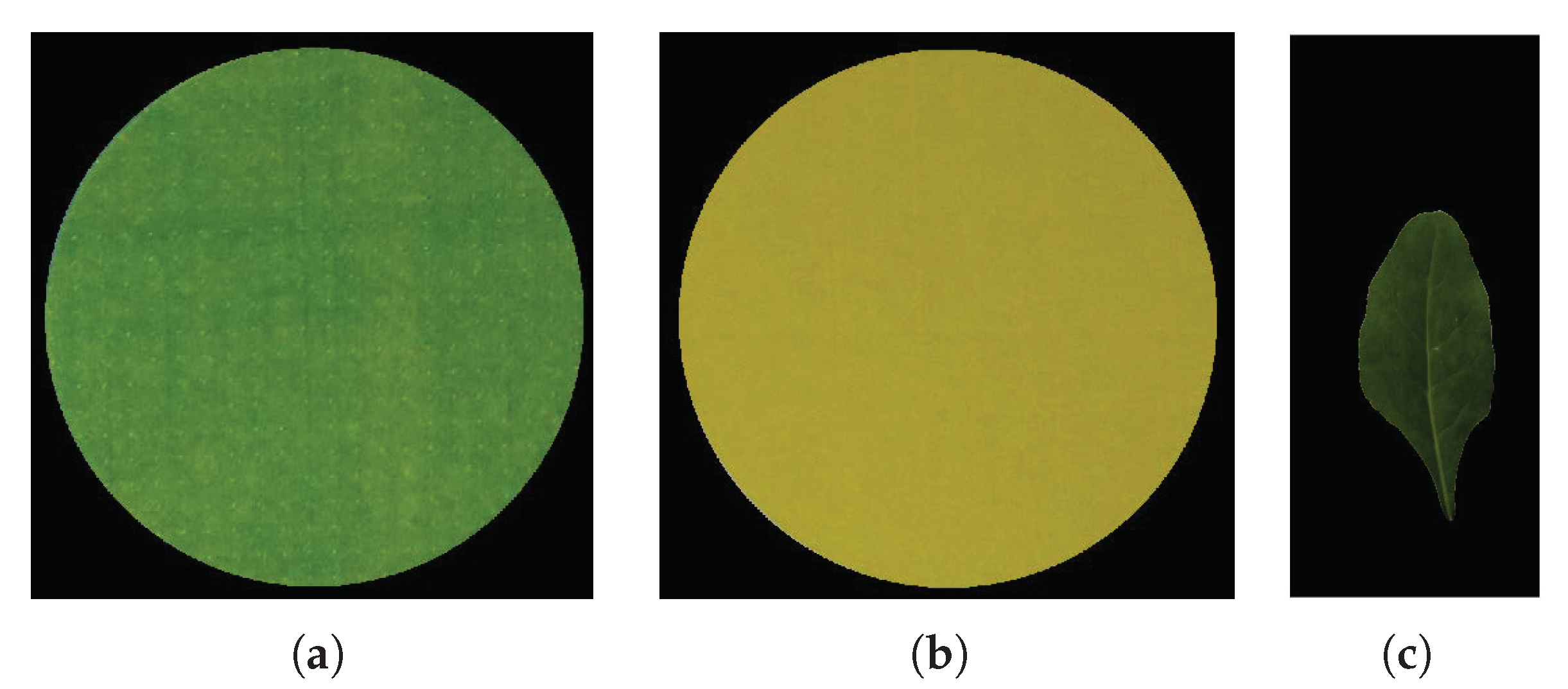
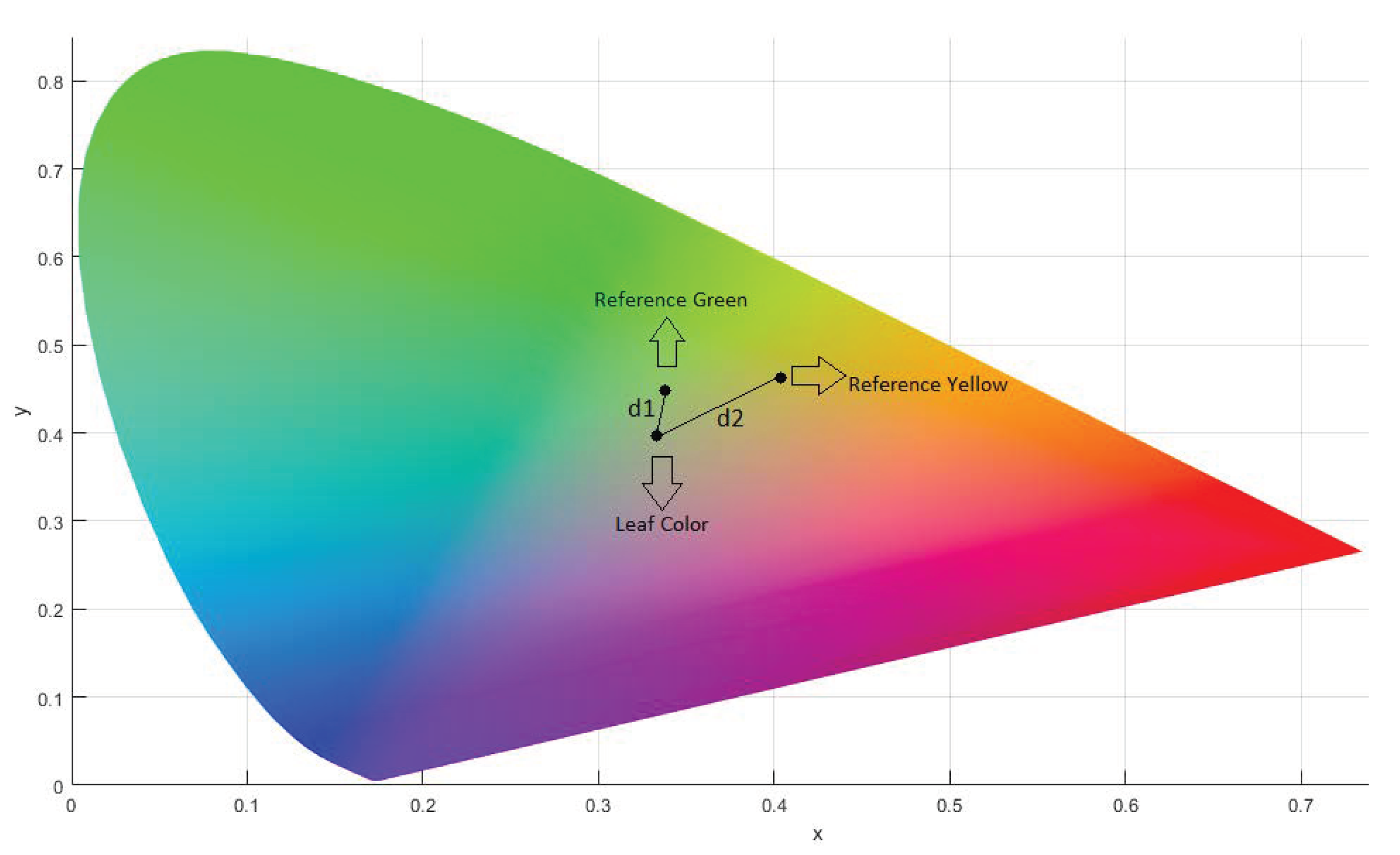
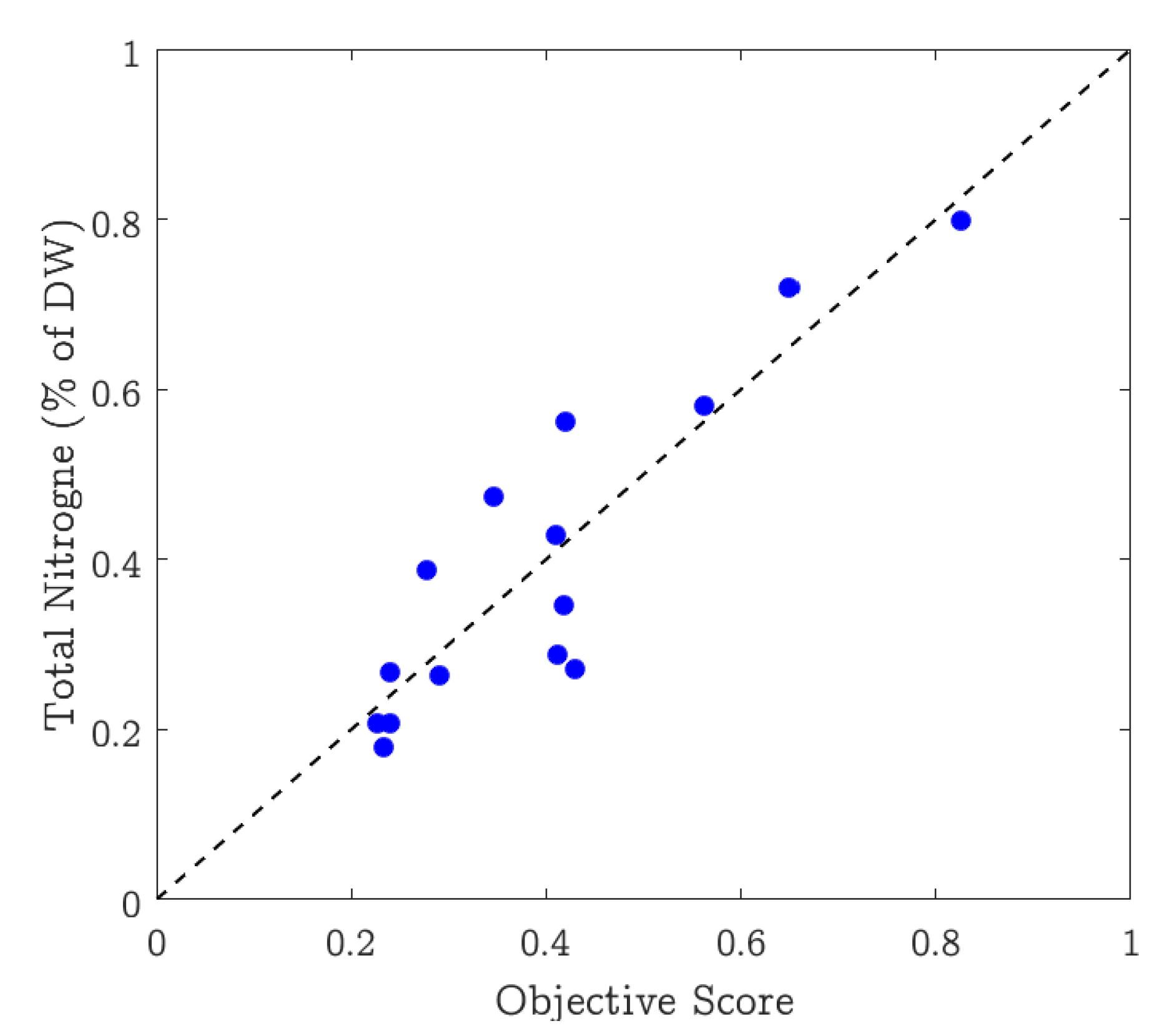
| Method | R | PLCC | SROCC | KROCC | RMSE |
|---|---|---|---|---|---|
| Euclidean | 0.6571 | 0.8107 | 0.6143 | 0.4286 | 0.1058 |
| 0.6617 | 0.8140 | 0.4893 | 0.3524 | 0.1245 | |
| CIEXYZ | 0.1275 | 0.8156 | 0.5536 | 0.3714 | 0.1556 |
| CIE76 | 0.6644 | 0.4299 | 0.3539 | 0.2488 | 0.1140 |
| CIE94 | 0.6373 | 0.7996 | 0.4379 | 0.3636 | 0.1283 |
| CIEDE2000 | 0.9198 | 0.9590 | 0.7643 | 0.6190 | 0.0845 |
| CMC l:c | 0.1138 | 0.3374 | 0.1679 | 0.1238 | 0.1657 |
| Method | Description | Method | Description |
|---|---|---|---|
| M1 | R: average red component. | M10 | |
| M2 | G: average green component. | M11 | |
| M3 | B: average blue component. | M12 | |
| M4 | M13 | ||
| M5 | M14 | ||
| M6 | M15 | ||
| M7 | M16 | ||
| M8 | M17 | ||
| M9 |
| Method | R | PLCC | SROCC | KROCC | RMSE |
|---|---|---|---|---|---|
| M1 | 0.4625 | 0.6801 | 0.5143 | 0.4095 | 0.1568 |
| M2 | 0.3863 | 0.6215 | 0.4893 | 0.3905 | 0.1097 |
| M3 | 0.6918 | 0.8318 | −0.0357 | −0.0095 | 0.1392 |
| M4 | 0.1729 | 0.4158 | 0.4179 | 0.2762 | 0.1569 |
| M5 | 0.4128 | 0.6425 | 0.3893 | 0.2571 | 0.1856 |
| M6 | 0.1531 | 0.3913 | 0.1179 | 0.1238 | 0.1850 |
| M7 | 0.3192 | 0.5650 | 0.3429 | 0.2952 | 0.1635 |
| M8 | 0.3107 | 0.5574 | 0.4429 | 0.3524 | 0.1754 |
| M9 | 0.2036 | 0.4512 | 0.4786 | 0.3333 | 0.1644 |
| M10 | 0.1743 | 0.4175 | 0.2500 | 0.2190 | 0.1629 |
| M11 | 0.3206 | 0.5662 | 0.5286 | 0.3143 | 0.1414 |
| M12 | 0.3652 | 0.6043 | 0.4643 | 0.3143 | 0.1305 |
| M13 | 0.0456 | 0.2135 | 0.3357 | 0.2190 | 0.1671 |
| M14 | 0.3386 | 0.5819 | 0.4786 | 0.2952 | 0.1489 |
| M15 | 0.3868 | 0.6220 | 0.5321 | 0.3524 | 0.1330 |
| M16 | 0.3389 | 0.5821 | 0.4357 | 0.3333 | 0.1646 |
| M17 | 0.3070 | 0.5541 | 0.5214 | 0.3905 | 0.1558 |
| Proposed | 0.9198 | 0.9590 | 0.7643 | 0.6190 | 0.0845 |
| Method | R |
|---|---|
| Liu [69] | 0.89 |
| Muchecheti [70] | 0.89 |
| Pagola [71] | 0.60–0.95 |
| DGCI [72] | 0.80 |
| Tafolla M1 [73] | 0.90 |
| Tafolla M2 [73] | 0.91 |
| Kawashima [23] | 0.81 |
| Noh [74] | 0.86 |
| Borhan [75] | 0.88 |
| Graeff [76] | 0.82 |
| Proposed | 0.92 |
| Device | R |
|---|---|
| SPAD-502 | 0.90 |
| CCM-200-CCI | 0.81 |
| Dualex-4-Chl | 0.69 |
| GreenSeeker | 0.73 |
| atLeaf [73] | 0.91 |
| Proposed | 0.92 |
Publisher’s Note: MDPI stays neutral with regard to jurisdictional claims in published maps and institutional affiliations. |
© 2021 by the authors. Licensee MDPI, Basel, Switzerland. This article is an open access article distributed under the terms and conditions of the Creative Commons Attribution (CC BY) license (https://creativecommons.org/licenses/by/4.0/).
Share and Cite
Haider, T.; Farid, M.S.; Mahmood, R.; Ilyas, A.; Khan, M.H.; Haider, S.T.-A.; Chaudhry, M.H.; Gul, M. A Computer-Vision-Based Approach for Nitrogen Content Estimation in Plant Leaves. Agriculture 2021, 11, 766. https://doi.org/10.3390/agriculture11080766
Haider T, Farid MS, Mahmood R, Ilyas A, Khan MH, Haider ST-A, Chaudhry MH, Gul M. A Computer-Vision-Based Approach for Nitrogen Content Estimation in Plant Leaves. Agriculture. 2021; 11(8):766. https://doi.org/10.3390/agriculture11080766
Chicago/Turabian StyleHaider, Tazeem, Muhammad Shahid Farid, Rashid Mahmood, Areeba Ilyas, Muhammad Hassan Khan, Sakeena Tul-Ain Haider, Muhammad Hamid Chaudhry, and Mehreen Gul. 2021. "A Computer-Vision-Based Approach for Nitrogen Content Estimation in Plant Leaves" Agriculture 11, no. 8: 766. https://doi.org/10.3390/agriculture11080766
APA StyleHaider, T., Farid, M. S., Mahmood, R., Ilyas, A., Khan, M. H., Haider, S. T.-A., Chaudhry, M. H., & Gul, M. (2021). A Computer-Vision-Based Approach for Nitrogen Content Estimation in Plant Leaves. Agriculture, 11(8), 766. https://doi.org/10.3390/agriculture11080766







